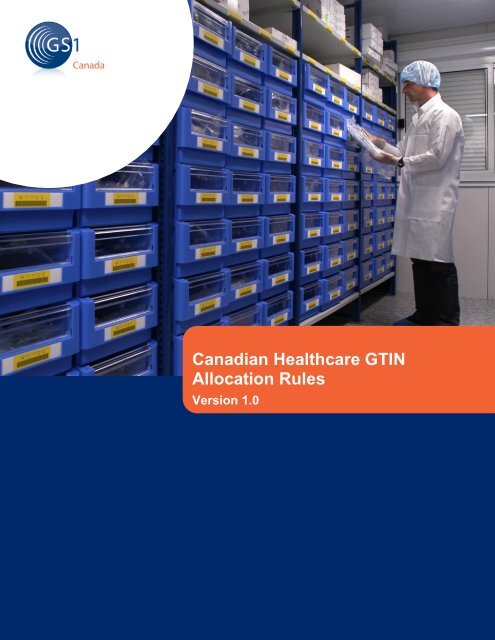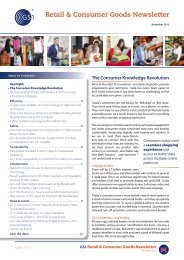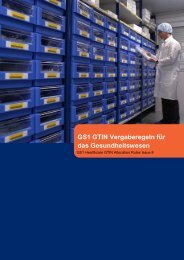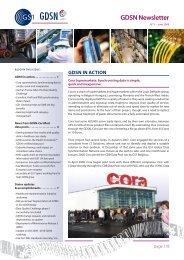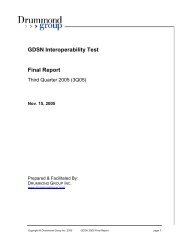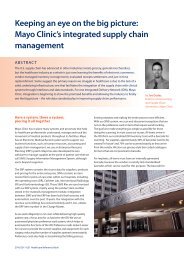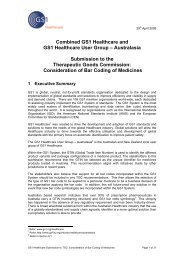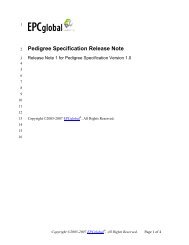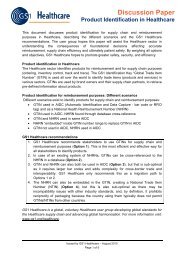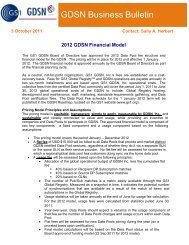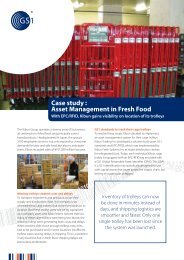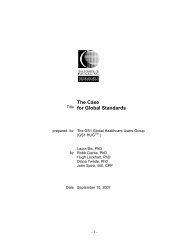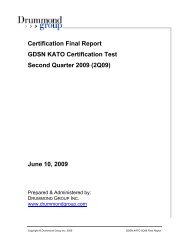Canadian GTIN Allocation Rules for Healthcare - GS1
Canadian GTIN Allocation Rules for Healthcare - GS1
Canadian GTIN Allocation Rules for Healthcare - GS1
You also want an ePaper? Increase the reach of your titles
YUMPU automatically turns print PDFs into web optimized ePapers that Google loves.
<strong>Healthcare</strong> <strong>GTIN</strong> <strong>Allocation</strong> <strong>Rules</strong><br />
<strong>Canadian</strong> <strong>Healthcare</strong> <strong>GTIN</strong><br />
<strong>Allocation</strong> <strong>Rules</strong><br />
Version 1.0<br />
03 October 2007, Final All contents copyright © <strong>GS1</strong> 2007 Page 1 of 26
<strong>Healthcare</strong> <strong>GTIN</strong> <strong>Allocation</strong> <strong>Rules</strong><br />
Table of Contents<br />
hhh<br />
1. Scope and Background ............................................................................................................. 5<br />
2. Introduction to Global Trade Item Number in <strong>Healthcare</strong> ....................................................... 5<br />
2.1. Definition of a <strong>GTIN</strong> ............................................................................................................................. 5<br />
2.1.1. <strong>GTIN</strong>s in <strong>Healthcare</strong> ................................................................................................................. 5<br />
2.1.2. Structure of a <strong>GTIN</strong> .................................................................................................................. 6<br />
2.2. <strong>Healthcare</strong> Items (definitions) .............................................................................................................. 7<br />
2.2.1. Pharmaceutical Products ......................................................................................................... 7<br />
2.2.2. Medical Devices ....................................................................................................................... 8<br />
2.3. Data Requirements in <strong>Healthcare</strong> ....................................................................................................... 9<br />
2.3.1. Global Trade Item Number (<strong>GTIN</strong>)........................................................................................... 9<br />
2.3.2. Serial Number .......................................................................................................................... 9<br />
3. Regulators ................................................................................................................................ 10<br />
4. Allocating the Numbers .......................................................................................................... 10<br />
4.1. General Rule ...................................................................................................................................... 10<br />
4.2. Responsibility ..................................................................................................................................... 10<br />
4.2.1. Branded Items ........................................................................................................................ 10<br />
4.3. Guidelines <strong>for</strong> Allocating Global Trade Item Numbers ...................................................................... 11<br />
4.3.1. Pre-Defined Characteristics ................................................................................................... 11<br />
4.3.2. Permanent <strong>GTIN</strong> assignment ................................................................................................. 11<br />
4.3.3. Lead time in Re-Use of a <strong>GTIN</strong> .............................................................................................. 12<br />
4.3.4. Prepriced Merchandise .......................................................................................................... 12<br />
4.3.5. Trade Item Changes ............................................................................................................... 12<br />
4.4. Packaging Level ................................................................................................................................ 12<br />
4.5. Takeovers .......................................................................................................................................... 13<br />
4.5.1. Acquisitions and Mergers ....................................................................................................... 13<br />
4.5.2. Partial Purchase ..................................................................................................................... 13<br />
4.5.3. Split or Spin-Off ...................................................................................................................... 14<br />
4.6. Data alignment ................................................................................................................................... 14<br />
4.6.1. Data Alignment Best Practice................................................................................................. 14<br />
5. <strong>GTIN</strong> <strong>Allocation</strong> Rule Interpretation & Resolution ................................................................ 14<br />
6. <strong>GTIN</strong> <strong>Allocation</strong> Scenarios ...................................................................................................... 15<br />
6.1. Over the Counter (OTC) .................................................................................................................... 15<br />
6.1.1. General <strong>Rules</strong> and Over the Counter (OTC).......................................................................... 15<br />
6.1.2. Different Language or Target Market ..................................................................................... 16<br />
03 October 2007, Final All contents copyright © <strong>GS1</strong> 2007 Page 2 of 26
<strong>Healthcare</strong> <strong>GTIN</strong> <strong>Allocation</strong> <strong>Rules</strong><br />
6.1.3. Additional Language on the Packaging Sold in Several Markets .......................................... 16<br />
6.1.4. Changes in packaging materials or minor artwork changes .................................................. 16<br />
6.1.5. Promotions ............................................................................................................................. 17<br />
6.1.6. Declared Change in Net Content ........................................................................................... 18<br />
6.1.7. Groupings of same item containing different quantities ......................................................... 18<br />
6.1.8. New/additional pallet layouts that co-exist permanently with the original layout ................... 19<br />
6.2. Medical Prescription (Rx) ................................................................................................................... 20<br />
6.2.1. General <strong>Rules</strong> <strong>for</strong> Medical Prescription (Rx) drugs ................................................................ 20<br />
6.3. Medical Devices ................................................................................................................................. 20<br />
6.3.1. General <strong>Rules</strong> <strong>for</strong> Medical Devices ........................................................................................ 20<br />
6.3.2. Minor Software Configuration Change ................................................................................... 21<br />
6.3.3. Major Software Configuration Change ................................................................................... 21<br />
6.3.4. Inclusion of a Certification Mark ............................................................................................. 21<br />
6.3.5. Kits (Combinations of Independent Items each with a Separate <strong>GTIN</strong>) ................................ 22<br />
6.3.6. Barrier Packs (Sterile Packaging) .......................................................................................... 24<br />
A. Glossary of Terms ................................................................................................................... 25<br />
Document Summary<br />
Document Item<br />
Document Title<br />
Current Value<br />
<strong>Canadian</strong> <strong>Healthcare</strong> <strong>GTIN</strong> <strong>Allocation</strong> <strong>Rules</strong><br />
V 0.01 DRAFT<br />
Date Last Modified 07 March 2011<br />
Current Document Issue 0.01<br />
Status<br />
Document Description<br />
Draft<br />
<strong>GTIN</strong> <strong>Allocation</strong> <strong>Rules</strong> <strong>for</strong> the <strong>Canadian</strong> <strong>Healthcare</strong> Sector<br />
Note: This document is based on the <strong>GS1</strong> General Specifications Section 2.1.A.1 Version 7.1 - Jan 2007<br />
Disclaimer<br />
Whilst every ef<strong>for</strong>t has been made to ensure that the guidelines to use the <strong>GS1</strong> standards contained in the<br />
document are correct, <strong>GS1</strong> and any other party involved in the creation of the document HEREBY STATE that<br />
the document is provided without warranty, either expressed or implied, of accuracy or fitness <strong>for</strong> purpose, AND<br />
HEREBY DISCLAIM any liability, direct or indirect, <strong>for</strong> damages or loss relating to the use of the document. The<br />
document may be modified, subject to developments in technology, changes to the standards, or new legal<br />
requirements. Several products and company names mentioned herein may be trademarks and/or registered<br />
trademarks of their respective companies.<br />
Note: All images in this document are <strong>for</strong> illustrative purposes only.<br />
03 October 2007, Final All contents copyright © <strong>GS1</strong> 2007 Page 3 of 26
<strong>Healthcare</strong> <strong>GTIN</strong> <strong>Allocation</strong> <strong>Rules</strong><br />
03 October 2007, Final All contents copyright © <strong>GS1</strong> 2007 Page 4 of 26
<strong>Healthcare</strong> <strong>GTIN</strong> <strong>Allocation</strong> <strong>Rules</strong><br />
1. Scope and Background<br />
Unique identification provides an opportunity to differentiate, in a machine readable <strong>for</strong>m, an item’s<br />
identification. Such in<strong>for</strong>mation is rapidly becoming a pre-requisite, when linked with the item’s batch<br />
number (or unique serial number) and expiration date, <strong>for</strong> traceability of all <strong>Healthcare</strong> products from<br />
production to delivery to the patient (point of care). This voluntary guideline was developed by the <strong>GS1</strong><br />
<strong>Healthcare</strong> User Group so that, when and where product identification is required there will be<br />
consistency in the use of a data structures worldwide. It also covers the specific Point of Sale<br />
requirements which are essential <strong>for</strong> Over The Counter healthcare items.<br />
The <strong>GS1</strong> <strong>Healthcare</strong> User Group is developing, promoting and implementing global industry standards<br />
<strong>for</strong> solutions to prevent medical errors, combat counterfeit products and improve supply chain<br />
efficiencies throughout the healthcare industry. The initial focus has primarily been on Pharmaceutical<br />
and Medical Devices and thus this document reflects the current engaged representation. While the<br />
principles and examples given may be applied to the entire healthcare sector, further development<br />
and updates to ensure that specific examples from animal health, dental products, etc may be added.<br />
Should a sector believe it is necessary to provide further input or additions to this document it should<br />
approach the <strong>GS1</strong> <strong>Healthcare</strong> User Group to initiate these discussions.<br />
Note: The <strong>GS1</strong> <strong>Healthcare</strong> User Group website (http://www.gs1.org/healthcare) is continuously<br />
updated.<br />
2. Introduction to Global Trade Item Number in<br />
<strong>Healthcare</strong><br />
2.1. Definition of a <strong>GTIN</strong><br />
The Global Trade Item Number (<strong>GTIN</strong> ) is used <strong>for</strong> the unique identification of trade items<br />
worldwide. <strong>GTIN</strong>s may be 8, 12, 13 or 14-digits in length. Their data structures require up to 14-digit<br />
fields, and all <strong>GTIN</strong> processing software should allow <strong>for</strong> 14 digits.<br />
A trade item is any item (product or service) upon which there is a need to retrieve pre-defined<br />
in<strong>for</strong>mation and that may be priced, or ordered, or invoiced at any point in any supply chain. This<br />
includes individual items as well as all their different configurations in different types of packaging.<br />
2.1.1. <strong>GTIN</strong>s in <strong>Healthcare</strong><br />
Global Trade Item Numbers (<strong>GTIN</strong>s) uniquely identify items that are traded (Pharmaceuticals, Medical<br />
Devices, etc) in the Supply Chain. Integrity of these numbers throughout the item’s lifetime is a key to<br />
maintaining uniqueness <strong>for</strong> manufacturers, wholesalers, distributors, hospitals, regulatory bodies and<br />
other Supply Chain stakeholders. A change to one aspect, characteristic, variant or <strong>for</strong>mulation of a<br />
trade item may require the allocation of a new <strong>GTIN</strong>.<br />
Brand Owners who hold the specifications of a healthcare item must properly allocate and maintain<br />
their <strong>GTIN</strong>s to enable trading partners to distinguish products effectively <strong>for</strong> regulatory, Supply Chain<br />
and patient safety concerns.<br />
This publication is based upon the <strong>GS1</strong> <strong>GTIN</strong> <strong>Allocation</strong> <strong>Rules</strong> www.gs1.org/gtinrules and has been<br />
tailored to meet the specific needs of <strong>Healthcare</strong>. While all <strong>GS1</strong> Standards are voluntary, the rules are<br />
intended to drive consistent implementation in the Global <strong>Healthcare</strong> Community.<br />
03 October 2007, Final All contents copyright © <strong>GS1</strong> 2007 Page 5 of 26
<strong>Healthcare</strong> <strong>GTIN</strong> <strong>Allocation</strong> <strong>Rules</strong><br />
Note: National, federal or local regulations may apply and will take precedence over this<br />
voluntary guideline. For example, some healthcare regulators may place requirements or<br />
restrictions on <strong>GTIN</strong> use within their jurisdiction.<br />
2.1.2. Structure of a <strong>GTIN</strong><br />
Upon joining a <strong>GS1</strong> Member Organisation companies receive a <strong>GS1</strong> Company Prefix and full<br />
documentation on how to allocate <strong>GTIN</strong>s to their products. The four methods to construct a <strong>GTIN</strong> are<br />
explained in detail the web site http://www.gs1.org/productssolutions/idkeys.<br />
Although <strong>GTIN</strong>s have an administrative structure to ensure that they are unique, they should be<br />
treated as non-significant numbers. This means that they should always be recorded and processed in<br />
their entirety; no part of the number relates to any classification or conveys any in<strong>for</strong>mation.<br />
Note: This <strong>GTIN</strong> <strong>for</strong>mat is used in business transactions, especially <strong>for</strong> eCom (e.g., electronic<br />
orders, invoices, price catalogues, etc.)<br />
Figure 2-1 shows the construct of the <strong>GTIN</strong>-13<br />
Figure 2-1 Example of a <strong>GTIN</strong>-13<br />
<strong>GS1</strong> Company Prefix Item Reference Check<br />
Digit<br />
N 1 N 2 N 3 N 4 N 5 N 6 N 7 N 8 N 9 N 10 N 11 N 12 N 13<br />
<strong>GS1</strong> Company Prefix<br />
■ The <strong>GS1</strong> Company Prefix consists of a <strong>GS1</strong> Prefix and the Company Number both of which<br />
are allocated by <strong>GS1</strong> Member Organisations and <strong>for</strong>m the <strong>GS1</strong> Company Prefix. In general it<br />
comprises six to ten digits depending on the capacity needs of the company.<br />
■<br />
The first two or three digits N 1 , N 2 , N 3 constitute the <strong>GS1</strong> Prefix allocated by <strong>GS1</strong> Global Office<br />
to each <strong>GS1</strong> Member Organisation. It does not mean that the item is produced or distributed<br />
in the country to which the prefix has been allocated. The <strong>GS1</strong> Company Number that follows<br />
the <strong>GS1</strong> Prefix is allocated by the Member Organisation.<br />
Item Reference<br />
■<br />
The Item Reference is a component of the Global Trade Item Number (<strong>GTIN</strong>) assigned by the owner of<br />
the <strong>GS1</strong> Company Prefix or U.P.C. Company Prefix to create a unique <strong>GTIN</strong> and is a non-significant<br />
number, which means that the individual digits in the number do not relate to any classification or<br />
convey any specific in<strong>for</strong>mation. The simplest way to allocate Item References is sequentially, that is<br />
000, 001, 002, 003, etc.<br />
Check Digit<br />
■<br />
The Check Digit is the last digit. It is calculated from all other digits in the <strong>GTIN</strong>.<br />
Figure 2-2 Example of a <strong>GTIN</strong>-14<br />
<strong>GTIN</strong>-14 Data<br />
Structure<br />
Indicator <strong>GTIN</strong> of the items contained (without Check Digit) Check<br />
Digit<br />
N 1 N 2 N 3 N 4 N 5 N 6 N 7 N 8 N 9 N 10 N 11 N 12 N 13 N 14<br />
03 October 2007, Final All contents copyright © <strong>GS1</strong> 2007 Page 6 of 26
<strong>Healthcare</strong> <strong>GTIN</strong> <strong>Allocation</strong> <strong>Rules</strong><br />
Indicator<br />
■ The Indicator is only used in the <strong>GTIN</strong>-14 Data Structure. It takes the value 1 to 8 (see Note 1<br />
below) and is used <strong>for</strong> higher packaging levels (See section 5.4, Packaging Level). The<br />
simplest way to allocate the indicator is sequentially that is 1, 2, 3… to each grouping of a<br />
trade unit.<br />
A uni<strong>for</strong>m grouping of trade items is a standard and stable grouping of identical trade items. The<br />
manufacturer or supplier has the option of either assigning a unique <strong>GTIN</strong>-13 or <strong>GTIN</strong>-12 to each<br />
grouping or assigning a unique <strong>GTIN</strong>-14 with an Indicator value of 1 to 8. These 14-digit <strong>GTIN</strong>s<br />
incorporate the <strong>GTIN</strong> of the trade item (less its Check Digit) contained in each grouping. The Check<br />
Digit <strong>for</strong> each <strong>GTIN</strong>-14 is then recalculated.<br />
The Indicators have no meaning. The digits do not have to be used in sequential order and some may<br />
not be used at all. The <strong>GTIN</strong>-14 structure <strong>for</strong> standard trade item groupings creates extra numbering<br />
capacity. Indicators can be re-used.<br />
Note 1: The value 9 is reserved <strong>for</strong> variable quantity items. These are rare in <strong>Healthcare</strong> but an<br />
example could be gases used in operations. The amount of gas used <strong>for</strong> any given operation is<br />
variable but can be priced or ordered or invoiced in predefined quantities (e.g., cubic meters)<br />
when delivered to a hospital.<br />
The Indicator is a digit with a value of 1 to 8. It is assigned as required by the company that constructs<br />
the identification number. It can provide up to eight separate EAN/UCC-14 Identification Numbers to<br />
identify groupings of trade items.<br />
The 8-, 12- or a 13-digit <strong>GTIN</strong> of the trade items contained must always be the one of the relevant<br />
levels of packaging contained, usually the lowest level. <strong>GTIN</strong>s <strong>for</strong> restricted distribution must not be<br />
used in this Element String.<br />
2.2. <strong>Healthcare</strong> Items (definitions)<br />
The legal definitions <strong>for</strong> healthcare items will differ from one country to another (see Section 3,<br />
Regulators). Indeed some legal definitions <strong>for</strong> drugs are simply ‘A substance recognised by an official<br />
legal entity’. This section there<strong>for</strong>e aims to provide a global overview.<br />
2.2.1. Pharmaceutical Products<br />
2.2.1.1. Over the Counter (OTC)<br />
An OTC is a pharmaceutical product, drug, or medicinal specialty whose dispensing or administration<br />
does not require medical authorization. Normally it can be used by the consumers under their own<br />
initiative and responsibility to prevent, relieve or to treat symptoms or mild diseases. Its use, in the<br />
<strong>for</strong>m, conditions and authorized dosages should be safe <strong>for</strong> the consumer.<br />
This covers healthcare items, pharmaceutical, and medical devices that do not require a medical<br />
prescription or direct medical intervention. Typical examples include bandages, first-aid kits,<br />
mouthwash, low-strength pain-killers, etc.<br />
2.2.1.2. Medical Prescription (Rx)<br />
A Medical Prescription (often referred to as a Pharmaceutical) Product (Rx) is a drug or medicinal<br />
specialty that requires a medical prescription or direct medical intervention. Typical examples include,<br />
medicated bandages, pain medication, injectables etc and can normally only be obtained with a<br />
prescription from an appropriate health care practitioner.<br />
03 October 2007, Final All contents copyright © <strong>GS1</strong> 2007 Page 7 of 26
<strong>Healthcare</strong> <strong>GTIN</strong> <strong>Allocation</strong> <strong>Rules</strong><br />
2.2.1.3 Hospital Pharmacy Production<br />
A Hospital Pharmacy Product is a product that has to be manufactured by a hospital pharmacy <strong>for</strong><br />
internal or multi-hospital use, thus it is not (or is no more) marketed by pharmaceutical company that<br />
supplied the raw material. These products may correspond to the Rx or OTC category. In any case,<br />
they have to be clearly identified from the production to the bedside.<br />
2.2.2. Medical Devices<br />
Medical device means any instrument, apparatus, implement, machine, appliance, implant, in vitro<br />
reagent or calibrator, software, material or other similar or related article, intended by the manufacturer<br />
to be used, alone or in combination, <strong>for</strong> human beings <strong>for</strong> one or more of the specific purposes of:<br />
■<br />
■<br />
■<br />
■<br />
■<br />
■<br />
■<br />
diagnosis, prevention, monitoring, treatment or alleviation of disease<br />
diagnosis, monitoring, treatment, alleviation of or compensation <strong>for</strong> an injury<br />
investigation, replacement, modification, or support of the anatomy or of a physiological<br />
process<br />
supporting or sustaining life<br />
control of conception<br />
disinfection of medical devices<br />
providing in<strong>for</strong>mation <strong>for</strong> medical purposes by means of in vitro examination of specimens<br />
derived from the human body and which does not achieve its primary intended action in or on<br />
the human body by pharmacological, immunological or metabolic means, but which may be<br />
assisted in its function by such means.<br />
03 October 2007, Final All contents copyright © <strong>GS1</strong> 2007 Page 8 of 26
<strong>Healthcare</strong> <strong>GTIN</strong> <strong>Allocation</strong> <strong>Rules</strong><br />
2.3. Data Requirements in <strong>Healthcare</strong><br />
2.3.1. Global Trade Item Number (<strong>GTIN</strong>)<br />
By joining a <strong>GS1</strong> Member Organisation the company receives a <strong>GS1</strong> Company Prefix which gives the<br />
company the ability to create <strong>GTIN</strong>s and access to the <strong>GS1</strong> Standards. The <strong>GS1</strong> System is designed<br />
to be used in any industry or any part of the public sector so that an individual company can select to<br />
allocate <strong>GTIN</strong>s using a <strong>GS1</strong> Company Prefix from the <strong>GS1</strong> Member Organisation of their choice.<br />
However, some Regulators impose mandatory local requirements on the use of <strong>GTIN</strong> within their<br />
jurisdiction (see 3, Regulators).<br />
Attributes such as Batch Number, Expiration Date, Serial Number, etc. add value to the product when<br />
combined with the <strong>GTIN</strong> in a <strong>GS1</strong> bar code using the <strong>GS1</strong> Application Identifiers. Their use enables<br />
tracking & tracing systems and can contribute to improving patient safety. For more in<strong>for</strong>mation see<br />
the general guidelines http://www.gs1.org/healthcare.<br />
Within the <strong>GS1</strong> System the following attributes may only be used in association with a <strong>GTIN</strong>.<br />
2.3.1.1. Batch Number<br />
A Batch Number (Application Identifier (10)) is typically assigned at the point of manufacturer using, <strong>for</strong><br />
example, a production lot number, a shift number, a machine number, a time, or an internal production<br />
code. The data is alphanumeric and length is variable up to 20 alphanumeric characters.<br />
2.3.1.2. Expiration Date<br />
An Expiration Date (Application Identifier (17)) is often referred to as expiry date or maximum durability<br />
date and indicates the limit of consumption or use of a product (e.g., <strong>for</strong> pharmaceutical products it will<br />
indicate the possibility of an indirect health risk resulting from the ineffectiveness of the product after<br />
the date). It is always encoded as a fixed length six numeric characters with the structure YYMMDD<br />
where:<br />
■ YY = the tens and units of the year (e.g., 2003 = 03).<br />
■ MM = the number of the month (e.g., January = 01).<br />
■ DD = the number of the day of the relevant month (e.g., second day = 02).<br />
An Expiration Date and Time may also be expressed (Application Identifier (7003)). This structure<br />
is only used when the exact expiration time is critical to patient safety.<br />
2.3.2. Serial Number<br />
A Serial Number (Application Identifier (21)) is typically used on medical devices that need to be<br />
individually tracked and traced (e.g., wheel chairs, pacemakers, MRI scanners).<br />
03 October 2007, Final All contents copyright © <strong>GS1</strong> 2007 Page 9 of 26
<strong>Healthcare</strong> <strong>GTIN</strong> <strong>Allocation</strong> <strong>Rules</strong><br />
3. Regulators<br />
The healthcare industry is highly regulated and companies are required to comply with national,<br />
federal and/or local regulations.<br />
This guideline has been developed as a global standard to help companies meet the key requirement<br />
of Product Identification (also an enabler <strong>for</strong> encoding batch and expiration date). The broader <strong>GS1</strong><br />
Global <strong>Healthcare</strong> User Group has a regulatory affairs area on the website (see<br />
http://www.gs1.org/healthcare). The <strong>GS1</strong> <strong>Healthcare</strong> User Group advocates the use of global<br />
standardisation to aid compliance to the regulatory requirements of all countries. However, it must be<br />
stressed that national, federal or local regulations may apply and take precedence over any <strong>GS1</strong><br />
Standard.<br />
4. Allocating the Numbers<br />
4.1. General Rule<br />
A Global Trade Item Number (<strong>GTIN</strong>) is used to identify any item upon which there is a need to retrieve<br />
pre-defined in<strong>for</strong>mation and that may be priced or ordered or invoiced at any point in any Supply<br />
Chain. Typically this includes the lowest level of packaging as well as higher packaging levels.<br />
A separate unique <strong>GTIN</strong> is required whenever any of the pre-defined characteristics of an item are<br />
different in any way that is relevant to the trading process. This principle is demonstrated in the figure<br />
below where the two products have identical ingredients and brand names but require separate <strong>GTIN</strong>s as<br />
one product can be sold anywhere while the other requires a Pharmacist to distribute (because of the<br />
intended usage).<br />
Figure 5-1 Example of product change triggering a New <strong>GTIN</strong> be allocated<br />
The guiding principle is if any significant change is made and it is expected to distinguish a new<br />
trade item from an old trade item and use accordingly, a new <strong>GTIN</strong> should be assigned. This<br />
document aims to define global what is meant by significant change in <strong>Healthcare</strong> by way of practical<br />
examples.<br />
4.2. Responsibility<br />
4.2.1. Branded Items<br />
The Brand Owner, the organisation that owns the specifications of the trade item regardless of where<br />
and by whom it is manufactured, is responsible <strong>for</strong> the allocation of the Global Trade Item Number<br />
(<strong>GTIN</strong>). By joining a <strong>GS1</strong> Member Organisation, the company receives a <strong>GS1</strong> Company Prefix which<br />
03 October 2007, Final All contents copyright © <strong>GS1</strong> 2007 Page 10 of 26
<strong>Healthcare</strong> <strong>GTIN</strong> <strong>Allocation</strong> <strong>Rules</strong><br />
is <strong>for</strong> the sole use of the company to which it is assigned. The <strong>GS1</strong> Company Prefix may not be sold,<br />
leased or given, in whole or in part, <strong>for</strong> use by any other company.<br />
The Company that owns the product and makes the Regulatory Filing is responsible <strong>for</strong> the <strong>GTIN</strong><br />
<strong>Allocation</strong>. For <strong>Healthcare</strong> items it is common <strong>for</strong> national regulators to require the submission of a<br />
product filing from a legal entity based within the jurisdiction of the regulator. Such arrangements have<br />
no direct impact on <strong>GTIN</strong> <strong>Allocation</strong> but need to be covered by the normal contractual arrangements<br />
(e.g., licensed distributor, subsidiary, reseller, etc.).<br />
The Brand Owner can only be responsible <strong>for</strong> <strong>GTIN</strong> <strong>Allocation</strong> until the item leaves their control. For<br />
example a complex medical device can be reconfigured (e.g., new language, updated software, etc).<br />
Individual customer configuration there<strong>for</strong>e cannot impact <strong>GTIN</strong> <strong>Allocation</strong>.<br />
4.3. Guidelines <strong>for</strong> Allocating Global Trade Item Numbers<br />
4.3.1. Pre-Defined Characteristics<br />
Although this list is not exhaustive, the basic pre-defined characteristics of a trade item are:<br />
■<br />
■<br />
■<br />
■<br />
■<br />
■<br />
■<br />
■<br />
Product Name, Product Brand, and Product Description<br />
Formulation (active ingredients)<br />
Strength<br />
Dosage (or usage)<br />
Net quantity (weight, volume, or other dimension impacting trade)<br />
Packaging configuration<br />
Form, Fit or Function<br />
For groupings, the number of elementary items contained, and their subdivision in subpackaging<br />
units, the nature of the grouping (carton, pallet, box-pallet, flat-pallet…)<br />
A modification to any of the basic elements that characterise a trade item will usually lead to a change<br />
in the <strong>GTIN</strong>.<br />
4.3.2. Permanent <strong>GTIN</strong> assignment<br />
Some healthcare products traded in Canada are subject to permanent assignment, also known as<br />
<strong>GTIN</strong> non-reuse. This means that once assigned, by the brand owner, these <strong>GTIN</strong>S can never be reassigned<br />
to another trade item. Permanent <strong>GTIN</strong> assignment rules supersede the normal rules of<br />
<strong>GTIN</strong> re-use (which are defined in the section below).<br />
Permanent <strong>GTIN</strong> assignment is necessary to ensure the long-term integrity of <strong>GTIN</strong> identification<br />
within patient records.<br />
The non-reuse of <strong>GTIN</strong>s refers to the restriction of reassigning the same <strong>GTIN</strong> to a different product<br />
or service. This restriction applies to:<br />
• Pharmaceutical products that have been assigned a Drug Identification Number (DIN) by<br />
Health Canada;<br />
• Biological (vaccine) products; and<br />
• Implant and medical/surgical products designated as Class II – Class IV by Health Canada.<br />
03 October 2007, Final All contents copyright © <strong>GS1</strong> 2007 Page 11 of 26
<strong>Healthcare</strong> <strong>GTIN</strong> <strong>Allocation</strong> <strong>Rules</strong><br />
4.3.3. Lead time in Re-Use of a <strong>GTIN</strong><br />
For other products used within healthcare (e.g. general merchandise, apparel, office products), <strong>GTIN</strong>s<br />
may be reassigned by the brand owner.<br />
A <strong>GTIN</strong> allocated to a trade item that has become obsolete must not be re-used <strong>for</strong> another trade item<br />
until at least 48 months have elapsed after:<br />
• the expiration date of the last original trade items produced with that number<br />
or,<br />
• the last original trade items produced with that number have been supplied to the customer.<br />
Brand Owners should consider a longer period depending upon the type of goods and/or any<br />
regulatory framework.<br />
In addition, when contemplating the re-use of a <strong>GTIN</strong>, consideration should be given to the use of<br />
data associated with the original <strong>GTIN</strong> by trading partners <strong>for</strong> statistical analysis or service records,<br />
which may continue long after the original trade item was last supplied.<br />
4.3.4. Prepriced Merchandise<br />
Prepricing is discouraged as a trade practice as it introduces complexity <strong>for</strong> trade item file<br />
maintenance through the Supply Chain. However, prepricing can be a mandatory requirement from<br />
the regulatory authorities there<strong>for</strong>e if the price that the consumer will pay is marked on the item, the<br />
Global Trade Item Number (<strong>GTIN</strong>) should be changed when the priced marked on the item changes.<br />
4.3.5. Trade Item Changes<br />
Trade item changes are any change or improvement during the life of a trade item where the new trade<br />
item replaces the old one. Should the Brand Owner decide to create a variant (e.g., with different active<br />
ingredient) in parallel with the standard trade item, then a separate <strong>GTIN</strong> has to be allocated.<br />
Minor trade item changes or improvements do not require the allocation of a different <strong>GTIN</strong>. Examples:<br />
artwork colour changes, outer packaging material change, etc.<br />
Major trade item changes or improvements do require the allocation of a different <strong>GTIN</strong> Examples: If a<br />
trade item’s quantity or measure changes or if any pre-defined characteristics are modified, then a<br />
new <strong>GTIN</strong> must be allocated.<br />
4.4. Packaging Level<br />
It is important that a different packaging level (e.g., Unit of Use Package, Shipper or Case, Pallet, etc)<br />
be assigned a different <strong>GTIN</strong>. Although it is <strong>for</strong> the Brand Owner to determine the exact level(s) to<br />
which a <strong>GTIN</strong> should be assigned typically any packaging level that is priced or ordered or invoiced<br />
at any point in any Supply Chain should receive its own <strong>GTIN</strong>.<br />
http://www.gs1.org/productssolutions/idkeys provides detailed examples and a typical packaging level<br />
example is shown in Figure 4-4.<br />
03 October 2007, Final All contents copyright © <strong>GS1</strong> 2007 Page 12 of 26
<strong>Healthcare</strong> <strong>GTIN</strong> <strong>Allocation</strong> <strong>Rules</strong><br />
Figure 4-4 Example of a Typical Packaging Level<br />
Unit of Use<br />
<strong>GTIN</strong> A<br />
Shipper Case<br />
<strong>GTIN</strong> B<br />
Pallet<br />
<strong>GTIN</strong> C<br />
Note: While the packaging level does not impact the <strong>GTIN</strong> of a specific item, each different<br />
grouping of the same item requires a separate <strong>GTIN</strong>.<br />
4.5. Takeovers<br />
4.5.1. Acquisitions and Mergers<br />
For the company being acquired, existing stocks on hand which are numbered be<strong>for</strong>e the acquisition<br />
or merger, keep the same Global Trade Item Numbers (<strong>GTIN</strong>s). Products that are produced after the<br />
acquisition or merger may keep the <strong>GTIN</strong> allocated be<strong>for</strong>e the acquisition if the acquiring company<br />
maintains the <strong>GS1</strong> Member Organisation membership.<br />
A merger implies that a legal entity has taken over a company and has assumed responsibility <strong>for</strong> the<br />
company’s <strong>GS1</strong> Company Prefix, as well as, their assets and locations. Products that the company<br />
produced under its <strong>GS1</strong> Company Prefix can still be produced using the same prefix after the merger,<br />
as full responsibility <strong>for</strong> the <strong>GS1</strong> Company Prefix is unaffected. If it so desires, the new company can<br />
label all acquired products using only one of their existing <strong>GS1</strong> Company Prefix.<br />
The importance of ensuring trading partners are in<strong>for</strong>med of any changes, in a timely manner, cannot<br />
be overemphasised. A company should be careful when centralising the allocation of all numbers<br />
under one <strong>GS1</strong> Company Prefix, thus changing the <strong>GTIN</strong> of the existing products, which are otherwise<br />
unchanged. Centralising the allocation of all numbers under a single <strong>GS1</strong> Company Prefix should be<br />
an exception, as it results in additional work and data file maintenance <strong>for</strong> customers. Companies<br />
should notify their <strong>GS1</strong> Member Organisation of any legal status change, within one year, to facilitate a<br />
smooth transition.<br />
4.5.2. Partial Purchase<br />
If a company purchases a division of a company whose <strong>GS1</strong> Company Prefix is used in divisions not<br />
purchased, then the acquiring company must change the <strong>GTIN</strong>s <strong>for</strong> products in the purchased division<br />
within one year.<br />
In most cases the rules concerning the use of the seller’s <strong>GTIN</strong>s, and other <strong>GS1</strong> Identification Keys,<br />
should be taken into consideration when drawing up the purchase contract.<br />
At the earliest opportunity, the buyer should phase in new numbers, from its own range of numbers,<br />
<strong>for</strong> items whose brand name it has acquired. The buyer will be able to do this, <strong>for</strong> example, when<br />
packaging is redesigned or reprinted.<br />
Best practice in healthcare is that the selling company never reallocate the numbers used on products<br />
which are divested to another company.<br />
03 October 2007, Final All contents copyright © <strong>GS1</strong> 2007 Page 13 of 26
<strong>Healthcare</strong> <strong>GTIN</strong> <strong>Allocation</strong> <strong>Rules</strong><br />
4.5.3. Split or Spin-Off<br />
When a company splits into two or more separate companies it is necessary <strong>for</strong> each <strong>GS1</strong> Company<br />
Prefix assigned to the original company to be transferred to only one of the new companies. Any<br />
company left without a <strong>GS1</strong> Company Prefix will need to apply to a <strong>GS1</strong> Member Organisation to<br />
obtain one. The decision about which of the new companies should take the original <strong>GS1</strong> Company<br />
Prefixes should be made in such a way as to minimise the number of additional <strong>GTIN</strong>s required. The<br />
decision should be part of the legal arrangements of the new companies.<br />
It is not necessary <strong>for</strong> existing stocks of items to be renumbered. However, when any of the split or<br />
spin-off companies has trade items that are numbered with a <strong>GS1</strong> Company Prefix that it no longer<br />
holds the company should renumber those items using its own <strong>GS1</strong> Company Prefix when new<br />
labelling or packaging is produced. Customers should be notified well in advance of the changes.<br />
Split or spin-off companies that retain a <strong>GS1</strong> Company Prefix must keep a record of the <strong>GTIN</strong>s<br />
created that have been allocated to items they no longer own. Best practice in healthcare is to never<br />
reallocate the numbers used on products which are divested to another company.<br />
4.6. Data alignment<br />
When a new <strong>GTIN</strong> is assigned to a trade item, it is essential that the Brand Owner provide the detailed<br />
in<strong>for</strong>mation to trading partners about the item's characteristics (see Section 5.3.1, Pre-Defined<br />
Characteristics). It is essential that the in<strong>for</strong>mation associated with a <strong>GTIN</strong> is accurate and<br />
communicated in a timely manner.<br />
4.6.1. Data Alignment Best Practice<br />
A number of actions are vital to ensure that <strong>GTIN</strong>s are accurately communicated within the Supply<br />
Chain. These actions ensure that the data associated with any scanned bar code can be associated<br />
with accurate, up-to-date, data. This is particularly essential <strong>for</strong> items scanned in <strong>Healthcare</strong> Supply<br />
Chains where the absence of accurate data may have safety, product availability and/or regulatory<br />
con<strong>for</strong>mance implications.<br />
The <strong>GTIN</strong> provides a Supply Chain solution <strong>for</strong> the identification of any item and overall Supply Chain<br />
costs are minimised by all partners in the Supply Chain adhering to identical allocation rules as laid<br />
down in this publication.<br />
5. <strong>GTIN</strong> <strong>Allocation</strong> Rule Interpretation & Resolution<br />
As the industry moves <strong>for</strong>ward, trading partners may reach different interpretations of the agreed upon<br />
standards. These may need clarification or a method may be required <strong>for</strong> resolving disputes.<br />
The following recommended resolution process should be observed in the event of an issue between<br />
trading partners.<br />
Step 1: Trading Party Resolution<br />
Clarify that the issue falls within the <strong>GTIN</strong> <strong>Allocation</strong> Rule recommendations (i.e. verify the issue<br />
relates to established product identification guidelines). These guidelines were developed through a<br />
lengthy consultation process to ensure that the business requirements of all stakeholders were met.<br />
03 October 2007, Final All contents copyright © <strong>GS1</strong> 2007 Page 14 of 26
<strong>Healthcare</strong> <strong>GTIN</strong> <strong>Allocation</strong> <strong>Rules</strong><br />
Most issues can be resolved through discussion between the trading partners in order to gain a<br />
thorough understanding of the issues at hand. <strong>GS1</strong> encourages all trading partners to exhaust this<br />
avenue as the first and most direct course of action.<br />
Step 2: Industry Ombudsman Recommendation<br />
If trading partner dialogue does not facilitate a resolution the issue can be raised to the level of the<br />
<strong>GTIN</strong> Industry Ombudsman (<strong>GS1</strong> Canada).<br />
The <strong>GTIN</strong> Ombudsman’s Role<br />
1. Provide <strong>GTIN</strong> <strong>Allocation</strong> Rule subject matter expertise<br />
• Bring clarity to industry standards and best practice guidelines<br />
2. Remain neutral and guide the parties to a feasible resolution<br />
• Propose a path <strong>for</strong>ward<br />
Either trading partner may request the services of the Industry Ombudsman. The Ombudsman can<br />
be reached by email at <strong>GS1</strong> Canada: <strong>GTIN</strong>OMBUDSMAN@gs1ca.org<br />
Step 3: <strong>GS1</strong> Sector Board Recommendation<br />
If the issue cannot be resolved to the mutual satisfaction of all, then an official complaint can be<br />
registered with the <strong>GS1</strong> Chief Standards Officer.<br />
The complainant shall submit a description of the issue, the Industry Ombudsman’s<br />
recommendation(s) and why this approach cannot be implemented<br />
The matter will be tabled with the appropriate <strong>GS1</strong> Sector Board (Pharmacy or <strong>Healthcare</strong>) <strong>for</strong><br />
consideration at their next meeting. The Board will consider the impact of the recommended solution<br />
on both the affected trading parties and on the Industry as a whole.<br />
The Board will provide its written recommendation on how the matter can best be resolved.<br />
Either trading partner may request escalation to the appropriate <strong>GS1</strong> Canada sector Board. The <strong>GS1</strong><br />
Canada Chief Standards Officer can be reached by email using the Ombudsman email:<br />
<strong>GTIN</strong>OMBUDSMAN@gs1ca.org<br />
.<br />
6. <strong>GTIN</strong> <strong>Allocation</strong> Scenarios<br />
6.1. Over the Counter (OTC)<br />
6.1.1. General <strong>Rules</strong> and Over the Counter (OTC)<br />
Although regulations (see Section 3, Regulators) are extremely important in this area, most Over The<br />
Counter items follow broadly similar allocation rules to those in the general retail environment (see<br />
www.gs1.org/gtinrules). The examples below focus on major <strong>Healthcare</strong> specific scenarios not found<br />
within the general retail environment.<br />
03 October 2007, Final All contents copyright © <strong>GS1</strong> 2007 Page 15 of 26
<strong>Healthcare</strong> <strong>GTIN</strong> <strong>Allocation</strong> <strong>Rules</strong><br />
There is a clear overlap between Over The Counter products and both Medical Devices and Medical<br />
Prescription (Rx) drugs. The general principles in this section apply to any type of <strong>Healthcare</strong> Item.<br />
6.1.2. Different Language or Target Market<br />
Figure 6-1 shows two otherwise identical products - one targeted <strong>for</strong> an English speaking country, the<br />
other <strong>for</strong> a Spanish speaking country. As the two items exist in parallel and can not be substituted (due<br />
to market acceptance and local labelling laws) a new language version to be sold in one<br />
Market/Country requires a different <strong>GTIN</strong> than the other that is sold in a different Market/Country.<br />
Figure 6-1 New <strong>GTIN</strong><br />
6.1.3. Additional Language on the Packaging Sold in Several Markets<br />
Unlike the single language packaging (see Section 6.1.2, Different Language or Target Market) many<br />
products are packed <strong>for</strong> multiple countries and markets. Where there is an addition to an existing<br />
language cluster, the <strong>GTIN</strong> will remain the same.<br />
Figure 6-2 Addition to an Existing Language Cluster - Same <strong>GTIN</strong><br />
6.1.4. Changes in packaging materials or minor artwork changes<br />
Minor artwork changes, or a minor change in packaging materials do not require the allocation of<br />
different <strong>GTIN</strong>s.<br />
Typically the gross dimensions of a trade item communicated via the Item File that do not affect net<br />
trade item quantity or measure do not impact the <strong>GTIN</strong> assignment. If dimensions are relevant<br />
anywhere in the supply chain, the general rule is that if any gross dimension (e.g. length, depth,<br />
weight, etc) changes by more than 20% a new <strong>GTIN</strong> is required. Changes below 20% may require a<br />
new <strong>GTIN</strong> at the discretion of the brand owner.<br />
03 October 2007, Final All contents copyright © <strong>GS1</strong> 2007 Page 16 of 26
<strong>Healthcare</strong> <strong>GTIN</strong> <strong>Allocation</strong> <strong>Rules</strong><br />
Figure 6-3 Minor Change in Packaging Materials - Same <strong>GTIN</strong><br />
Note: Minor changes - those which are not relevant to trading partners because they do not<br />
impact the in<strong>for</strong>mation concerning the exchange of products - do not require a change of <strong>GTIN</strong>.<br />
6.1.5. Promotions<br />
Promotions are normally short-term modifications to the way the item is presented. Promotions related<br />
to price do not impact <strong>GTIN</strong> allocation.<br />
Figure 6-4 Promotions Related to Price - Same <strong>GTIN</strong><br />
Note: Any promotion impacting the content of the product, or requiring a new Regulatory Filing,<br />
is considered a major change and a new <strong>GTIN</strong> must be assigned.<br />
03 October 2007, Final All contents copyright © <strong>GS1</strong> 2007 Page 17 of 26
<strong>Healthcare</strong> <strong>GTIN</strong> <strong>Allocation</strong> <strong>Rules</strong><br />
6.1.6. Declared Change in Net Content<br />
Any modification which leads to a declared change in the net content of a healthcare item requires a<br />
new <strong>GTIN</strong> to be assigned. Examples include: number of tablets in a package; the number of sterile<br />
wipes in a pack; the net volume of 400 grams in 4 helpings of 100 grams (<strong>for</strong> adult use) changed to<br />
400 grams in 8 helpings of 50 grams (<strong>for</strong> a child), etc.<br />
Figure 6-5 Declared Change in Net Content - New <strong>GTIN</strong><br />
In<strong>for</strong>mation systems need to distinguish between old and new healthcare items where there is a<br />
declared change in net content. Failure to distinguish old and new could lead to medical error and/or<br />
inaccurate unit pricing.<br />
Note: Improvements in manufacturing tolerances, that do not impact the declaration on the<br />
product in any way, do not require a <strong>GTIN</strong> change as the modification is only relevant to the<br />
manufacturer.<br />
6.1.7. Groupings of same item containing different quantities<br />
It is essential that each different packaging level (e.g., Unit of Use, Shipper, Case, etc) be assigned a<br />
different Global Trade Item Number (<strong>GTIN</strong>). The example below shows otherwise identical syringes in<br />
packs of one, three and five:<br />
■<br />
■<br />
The <strong>GTIN</strong> <strong>for</strong> each individual item is the same independent of any higher packing levels or<br />
use as part of a larger <strong>Healthcare</strong> Kit (See section (6.3.5, Kits (Combinations of Independent<br />
Items each with a Separate <strong>GTIN</strong>))<br />
Each grouping (the pack of one, three and five below) requires a separate <strong>GTIN</strong>.<br />
03 October 2007, Final All contents copyright © <strong>GS1</strong> 2007 Page 18 of 26
<strong>Healthcare</strong> <strong>GTIN</strong> <strong>Allocation</strong> <strong>Rules</strong><br />
Figure 6-6 Groupings of the same item containing different quantities<br />
6.1.8. New/additional pallet layouts that co-exist permanently with the original layout<br />
The pallet-layout does not impact <strong>GTIN</strong> allocation of items on the pallet (see section 6.1.7, Groupings<br />
of same item containing different quantities) and a <strong>GTIN</strong> is not normally required at the pallet level.<br />
However, if the market requires additional pallet configurations to be made available <strong>for</strong> ordering<br />
purposes, then different <strong>GTIN</strong>s are required <strong>for</strong> each pallet-pattern and/or pallet-layout.<br />
Figure 6-7 Additional Pallet Configurations <strong>for</strong> Ordering Purposes - New <strong>GTIN</strong><br />
03 October 2007, Final All contents copyright © <strong>GS1</strong> 2007 Page 19 of 26
<strong>Healthcare</strong> <strong>GTIN</strong> <strong>Allocation</strong> <strong>Rules</strong><br />
6.2. Medical Prescription (Rx)<br />
6.2.1. General <strong>Rules</strong> <strong>for</strong> Medical Prescription (Rx) drugs<br />
As with the General <strong>Rules</strong> that apply to all <strong>Healthcare</strong> Items (see section 5.1, General Rule),<br />
compliance to regulatory requirements always takes precedence (see section 3, Regulators). The<br />
additional general rules that apply specifically to the Medical Prescription (Rx) are:<br />
■<br />
■<br />
■<br />
Any change to the Regulatory Filing of a product (<strong>for</strong> example triggered by a <strong>for</strong>mulation,<br />
usage, concentration/potency, etc. change) will lead to new <strong>GTIN</strong>.<br />
In addition to the product identification (<strong>GTIN</strong>), Batch Number and Expiration Date are<br />
normally required in bar code <strong>for</strong>m.<br />
In the case where a Medical Prescription (Rx) Product is made-up specifically <strong>for</strong> an individual<br />
patient (<strong>for</strong> example in a hospital pharmacy) the normal <strong>GTIN</strong> rules may not be applicable. For<br />
these specialist ‘one-off’ preparations, it is suggested to bar code and number the product so<br />
that it is uniquely attributed to the individual patient.<br />
6.3. Medical Devices<br />
6.3.1. General <strong>Rules</strong> <strong>for</strong> Medical Devices<br />
The General <strong>Rules</strong> (see Section 5.1, General Rule) and the regulatory requirements (see Section 3,<br />
Regulators) apply to all <strong>Healthcare</strong> Items. In addition the complexity of the Medical Device market<br />
needs to be recognised. The illustrated example below showing a Ventilator made up of three<br />
component parts Global User Interface (GUI), Primary Unit & Battery. Each of these items could be<br />
ordered separately and may be configured <strong>for</strong> local requirements like language, electricity plugs,<br />
software, etc.<br />
Figure 6-8 Example of the complexity of a Medical Device product with regard to <strong>GTIN</strong> <strong>Allocation</strong><br />
Ventilator<br />
Configuration<br />
1. Language<br />
Three Component Parts<br />
1. GUI<br />
2. Primary Unit<br />
3. Battery<br />
2. Country of Use<br />
3. Firmware Revision<br />
4. Software Options<br />
5. Hardware Revision<br />
Independent<br />
Serial Numbers<br />
Commercial<br />
New <strong>GTIN</strong> ?<br />
<br />
<br />
<br />
<br />
<br />
Master Serial<br />
Number<br />
AI(21)<br />
Form, Fit or Function<br />
<br />
<br />
<br />
<br />
<br />
Additional Option <strong>GTIN</strong> ’ s<br />
A key consideration <strong>for</strong> <strong>GTIN</strong> <strong>Allocation</strong> is the commercialisation of the product (e.g., is the Medical<br />
Device considered different <strong>for</strong> pricing or ordering or invoicing). If the product is ‘different’ a ‘different<br />
<strong>GTIN</strong>’ is required.<br />
03 October 2007, Final All contents copyright © <strong>GS1</strong> 2007 Page 20 of 26
<strong>Healthcare</strong> <strong>GTIN</strong> <strong>Allocation</strong> <strong>Rules</strong><br />
The diagram above is a scenario to represent the difficulties in determining when a <strong>GTIN</strong> change is<br />
necessary <strong>for</strong> complex medical devices, depending upon how the device is viewed i.e. from a<br />
Commercial and / or Form, Fit, Function perspective. Nominally the commercial aspects of an FMCG<br />
trade item determine a <strong>GTIN</strong> change, the objective is to recognise that other important factors reside<br />
which may not necessarily signify a commercialization shift, but would impact the <strong>GTIN</strong> assignment <strong>for</strong><br />
<strong>Healthcare</strong>. It is the brand owner’s responsibility to manage appropriately the configuration of any<br />
complex device and its appropriate <strong>GTIN</strong>(s) assignment up to the point of sale. The example shows<br />
major hardware components managed by <strong>GTIN</strong> and Serial Number combinations, recognising that<br />
within this complex medical device there are other potential parameters where configuration change<br />
must be managed; <strong>GTIN</strong> change may be dictated based on the manufacturers change management<br />
process.<br />
Many Medical Devices, particularly high-value electronic equipment, will use the combination of <strong>GTIN</strong><br />
plus Serial Number <strong>for</strong> tracking purposes (rather than the <strong>GTIN</strong>, Batch Number and Expiration Date<br />
which are normally required in other areas of <strong>Healthcare</strong>). It is the Brand Owner that decides upon the<br />
identification requirement.<br />
6.3.2. Minor Software Configuration Change<br />
A minor change in software configuration, which is provided on a non-commercial basis and has no<br />
impact on the function of the device, has no impact on <strong>GTIN</strong> <strong>Allocation</strong>. Examples include bug fixes,<br />
language options (provided <strong>for</strong> free), minor version updates, etc.<br />
6.3.3. Major Software Configuration Change<br />
A major change in software configuration that adds to, or changes, the functionality requires the two<br />
configurations to be distinguishable through the allocation of different <strong>GTIN</strong>s. Such changes would<br />
normally be provided on a commercial basis and trading partners need to distinguish the two<br />
configurations <strong>for</strong> pricing or ordering or invoicing. Additional examples include software updates that<br />
provide additional product features, or signification version updates.<br />
Figure 6-9 Major Software Configuration Change – New <strong>GTIN</strong><br />
6.3.4. Inclusion of a Certification Mark<br />
Within the <strong>Healthcare</strong> sector there are many examples of certification marks. A certification mark is a<br />
symbol, logo or wording on a product that declares con<strong>for</strong>mance to a regulated set of criteria (e.g.,<br />
European Certification Mark CE). When a product is changed to include a certification mark (which<br />
was not previously shown on the packaging or product itself) a new <strong>GTIN</strong> should be allocated <strong>for</strong><br />
markets where the certification mark is of particular relevance. It is a key principle of <strong>GTIN</strong> <strong>Allocation</strong><br />
that the <strong>GTIN</strong> identifies uniquely the product and its packaging configuration.<br />
03 October 2007, Final All contents copyright © <strong>GS1</strong> 2007 Page 21 of 26
<strong>Healthcare</strong> <strong>GTIN</strong> <strong>Allocation</strong> <strong>Rules</strong><br />
Figure 6-10 Inclusion of a Certification Mark – New <strong>GTIN</strong><br />
Note: Brand owners are responsible <strong>for</strong> internal control of their inventory and any return<br />
systems. It is important that such systems, as well as phase-in & phase-out logistic<br />
management, can distinguish between ‘old’ and ‘new’ product. When this can be effectively<br />
achieved, <strong>for</strong> example using the batch number or product variant, there is no need to allocate a<br />
new <strong>GTIN</strong> in the scenario above. It should also be noted that when a certification mark is added<br />
to enable sales in a new country/market it has no impact on countries/markets where the<br />
product was previously sold – in this case there is no need to allocate a new <strong>GTIN</strong> in the<br />
scenario above.<br />
6.3.5. Kits (Combinations of Independent Items each with a Separate <strong>GTIN</strong>)<br />
A medical kit can be defined as any combination of items that <strong>for</strong>m a standard and stable grouping<br />
that can be individually priced or ordered or invoiced; the Brand Owner is responsible <strong>for</strong> <strong>GTIN</strong><br />
<strong>Allocation</strong>. When a kit contains items from multiple manufactures the <strong>GTIN</strong> (and normally any<br />
Regulatory Filing) requirements <strong>for</strong> the kit is the responsibility of the organisation that creates the kit.<br />
Note: Kits may contain Medical Prescription (Rx) products (see 6.2, Medical Prescription (Rx)).<br />
Some typical examples of kits are groupings of items required to per<strong>for</strong>m a given medical intervention.<br />
The three examples shown below demonstrate major and minor changes which impact <strong>GTIN</strong><br />
<strong>Allocation</strong> in different ways. The key principles are the commercialisation of the product (e.g., different<br />
<strong>for</strong> pricing or ordering or invoicing?) and the function (e.g., changes the intended usage?):<br />
Figure 6-11 Major Change to a kit – additional item impacts commercialisation and function.<br />
03 October 2007, Final All contents copyright © <strong>GS1</strong> 2007 Page 22 of 26
<strong>Healthcare</strong> <strong>GTIN</strong> <strong>Allocation</strong> <strong>Rules</strong><br />
Figure 6-12 <strong>GTIN</strong> change within a kit, Sterile Water component of the kit changed (bottle of sterile water has<br />
a <strong>GTIN</strong>), a new <strong>GTIN</strong> is assigned to the kit<br />
New<br />
<strong>GTIN</strong><br />
Note: The items within the kits may have their own <strong>GTIN</strong>s. A change to any <strong>GTIN</strong> within the kit<br />
will require a change to the <strong>GTIN</strong> of the kit itself.<br />
Figure 6-13 Minor Change to a kit by Brand Owner – cotton ball component of the kit changed with no<br />
impact on commercialisation, net content or function<br />
Note: If a Brand Owner changes an item within a kit and the item doesn't have a <strong>GTIN</strong>, the<br />
Brand Owner doesn't have to change the <strong>GTIN</strong> of the kit.<br />
03 October 2007, Final All contents copyright © <strong>GS1</strong> 2007 Page 23 of 26
<strong>Healthcare</strong> <strong>GTIN</strong> <strong>Allocation</strong> <strong>Rules</strong><br />
6.3.6. Barrier Packs (Sterile Packaging)<br />
As outlined in section 5.4, Packaging Level the general rule is that each packaging level requires a<br />
separate <strong>GTIN</strong>. However, <strong>for</strong> certain items, particularly sterile items, the multiple barrier packaging is<br />
not considered a Packaging Level <strong>for</strong> <strong>GTIN</strong> <strong>Allocation</strong>.<br />
The example below shows a typical product where the sterilisation requires several packaging levels<br />
(double barrier packaging). When the suture is used certain packaging levels may only be opened in a<br />
sterile environment, however, the same <strong>GTIN</strong> is used <strong>for</strong> the item and the 'sterile' barrier package level<br />
as the key principles <strong>for</strong> <strong>GTIN</strong> <strong>Allocation</strong> are the commercialisation of the product (e.g., different <strong>for</strong><br />
pricing or ordering or invoicing?) and the function (e.g., changes the intended usage?) and the sterile<br />
packaging levels have no impact on commercialisation or function.<br />
Figure 6-14 Barrier Packs (Sterile packaging)<br />
03 October 2007, Final All contents copyright © <strong>GS1</strong> 2007 Page 24 of 26
<strong>Healthcare</strong> <strong>GTIN</strong> <strong>Allocation</strong> <strong>Rules</strong><br />
A. Glossary of Terms<br />
Term<br />
Application Identifier<br />
Brand Owner<br />
<strong>GS1</strong> Company Prefix<br />
EPC<br />
<strong>GS1</strong> General<br />
Specifications<br />
<strong>GS1</strong> Global Office<br />
<strong>GS1</strong> Member<br />
Organisation<br />
<strong>GS1</strong> System<br />
<strong>GTIN</strong><br />
Item Reference<br />
Medical Device<br />
Over The Counter<br />
(OTC)<br />
Rx (Medical<br />
Prescription Product)<br />
Definition<br />
The field of two or more characters at the beginning of an Element String that<br />
uniquely defines its <strong>for</strong>mat and meaning.<br />
The party that is responsible <strong>for</strong> allocating <strong>GS1</strong> System numbering and bar code<br />
symbols on a given trade item. The administrator of a <strong>GS1</strong> Company Prefix.<br />
Part of the <strong>GS1</strong> System identification number consisting of a <strong>GS1</strong> Prefix and a<br />
Company Number, both of which are allocated by <strong>GS1</strong> Member Organisations.<br />
Electronic Product Code is an identification scheme <strong>for</strong> universally identifying<br />
physical objects via RFID tags and other means. See http://www.epcglobalinc.org<br />
Defines the <strong>GS1</strong> System data and application standards related to the marking and<br />
automatic identification of trade items, locations, logistic units, assets, and more<br />
using bar code, RFID, and <strong>GS1</strong> Identification Keys.<br />
Based in Brussels, Belgium, and Princeton, USA, is an organisation of <strong>GS1</strong> Member<br />
Organisations that manages the <strong>GS1</strong> System.<br />
A member of <strong>GS1</strong> that is responsible <strong>for</strong> administering the <strong>GS1</strong> System in its<br />
country (or assigned area). This task includes, but is not restricted to, ensuring user<br />
companies make correct use of the <strong>GS1</strong> System, have access to education,<br />
training, promotion and implementation support and have access to play an active<br />
role in GSMP.<br />
The specifications, standards, and guidelines administered by <strong>GS1</strong>.<br />
Global Trade Item Number used to identify any item (product or service) upon which<br />
there is a need to retrieve pre-defined in<strong>for</strong>mation and that may be priced, or<br />
ordered, or invoiced at any point in any Supply Chain.<br />
The part of the data structure allocated by the user to identify a trade item <strong>for</strong> a<br />
given <strong>GS1</strong> Company Prefix.<br />
Any instrument, apparatus, implement, machine, appliance, implant, in vitro reagent<br />
or calibrator, software, material or other similar or related article, intended by the<br />
manufacturer to be used, alone or in combination, <strong>for</strong> human beings <strong>for</strong> any medical<br />
purpose.<br />
A drug, or medicinal specialty whose dispensing or administration does not require<br />
medical authorization, and it can be used by the consumers under their own<br />
initiative and responsibility to prevent, relieve or to treat symptoms or mild diseases<br />
and that its use, in the <strong>for</strong>m, conditions and authorized dosages are safe <strong>for</strong> the<br />
consumer.<br />
A drug or medicinal specialty that requires a medical prescription or direct medical<br />
intervention. Typical examples include, medicated bandages, pain medication,<br />
injectables etc and can normally only be obtained with a prescription from an<br />
appropriate health care practitioner.<br />
03 October 2007, Final All contents copyright © <strong>GS1</strong> 2007 Page 25 of 26
<strong>Healthcare</strong> <strong>GTIN</strong> <strong>Allocation</strong> <strong>Rules</strong><br />
<strong>GS1</strong> - The global language of business<br />
03 October 2007, Final All contents copyright © <strong>GS1</strong> 2007 Page 26 of 26


